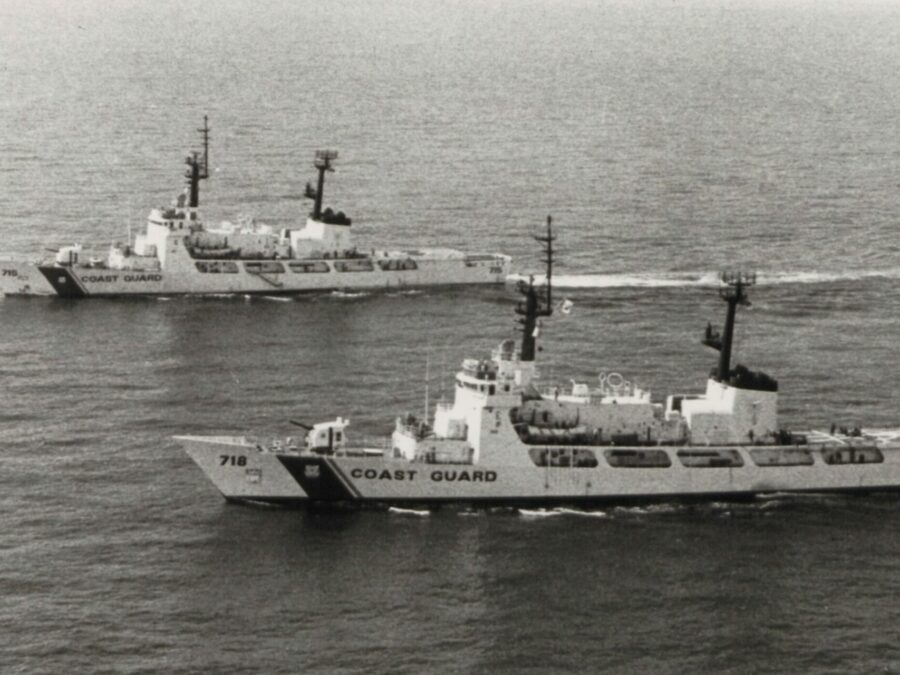
For the Coast Guard Cutter Chase (WHEC-718), the morning of Sunday, Oct. 25, 1981, began much as many other mornings had for cutters on counterdrug patrol in the Caribbean. The sky was clear, the temperature was a comfortable 84° F, and a light wind of 7 to 8 knots blew out of the north. As the cutter steamed about the Windward Passage at 10 to 13 knots, the bow of the 378-foot “Secretary”-Class, high-endurance cutter sliced cleanly through the seas of around two feet.
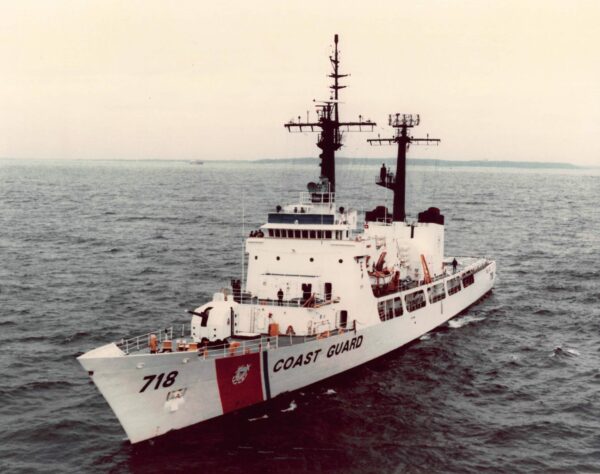
Late that morning, the cutter conducted Flight Operations to receive its assigned HH-52 helicopter (CG-1455), which had flown in from south Florida via Guantanamo Bay, Cuba. After conducting boat drills that afternoon, the helicopter was launched to conduct an extended search for suspect vessels beyond the cutter’s visual and radar detection ranges. At 5 p.m., in response to a sighting, Chase brought both gas turbines online and dashed at 24 knots to intercept a reported suspect vessel.
The description of this vessel did not fit the drug smuggling profile. Once on scene, Chase found the 35-foot Haitian sailing vessel Exoribe appeared so grossly overloaded with numerous persons on board that only a few inches of freeboard stood between sailing and swamping. Rather than smuggling drugs, the Exoribe would prove to be smuggling people, and would be the first vessel boarded under the newly implemented Haitian Migrant Interdiction Operation (HMIO).
Prior to the launch of HMIO, vessels carrying undocumented Haitians had been allowed to continue to or were even assisted to south Florida. There, the occupants would be processed by officials of the Immigration and Naturalization Service (INS) and generally “excluded”—which meant that they would be sent back to Haiti with no consideration of the merits of a potential claim of asylum. In contrast, if someone had entered the U.S. before being taken into custody—as many Haitians who arrived by commercial airline did, they were further detained pending determination of the validity of their claims for asylum.
This process had been manageable when the number of arriving of “boat people,” as undocumented Haitians attempting to reach the U.S. by sea were then called, was low—with only two documented events prior to 1971. It remained acceptable when more began trickling in starting in 1972, and even when the trickle turned to a steady flow in 1978; but in 1980 the situation changed dramatically.
While 1980 is most remembered for the arrival of 125,00 Cuban refugees during the Mariel Boatlift, thousands of Haitians also arrived in south Florida by sea that same year. They were collectively referred to as “Cuban-Haitian entrants.” The most important aspect of that designation was that “exclusion” was suspended. Entrants were allowed to file asylum claims and were paroled into the U.S. with refugee benefits while their claims were processed. This status would be extended to those who were in INS proceedings as of Oct. 10, 1980, regardless of when they had actually entered the U.S. Eventually the qualifying entry date would be extended to Jan. 1, 1982.
However, while the flow of Cuban migrants abruptly ended when Fidel Castro closed Cuba’s ports to emigration on Sept. 25, 1980, the flow of Haitians continued unabated, averaging over 700 arrivals per month. They were drawn by a quick succession of U.S. policies that seemed to promise jobs, security, and assistance. By the end of 1980, over 15,000 Haitians had sought refuge in the U.S. that year—with 3,000 of them having been assisted at sea by the Coast Guard.
The inauguration of President Ronald Reagan in January 1981 would bring change to U.S. immigration policy. Faced with local governments and social services in south Florida that were overwhelmed by the challenge of accommodating thousands of migrants, an economy that was sputtering, and a high unemployment rate, President Reagan soon issued Executive Order 12324.
In it, he directed the Secretary of State to negotiate “cooperative arrangements with appropriate foreign governments for the purpose of preventing illegal migration to the United States by sea,” and directed the Secretary of Transportation to “issue appropriate instructions to the Coast Guard in order to enforce the suspension of the entry of undocumented aliens and the interdiction of any defined vessel carrying such aliens.”
As directed, the State Department negotiated a bilateral agreement with Haiti allowing the Coast Guard to board Haitian vessels on the high seas, and if undocumented migrants were found, to return both the vessel and undocumented migrants to Haiti. Once the agreement was signed, the Secretary of Transportation, Drew Lewis, sent a memo, “High Seas Interdiction of Illegal Aliens,” to the Commandant of the Coast Guard, Adm. John B. Hayes. This memo gave some specific guidelines and “authorized other action as you may deem appropriate to effectively carry out this interdiction program.”
Accordingly, construction of the “White Picket Fence,” a metaphor for the barrier patrol conducted by the Coast Guard’s white-hulled cutters in the Windward Passage, began later that month. The Coast Guard’s concept of operations was to station a helicopter-equipped high endurance cutter in the Windward Passage, with additional reconnaissance support provided by fixed wing aviation assets based nearby at Navy Base Guantanamo Bay, Cuba.

Under the guidelines of the new HMIO, after a cutter stopped a vessel outbound from Haiti, an attached INS team consisting of an agent and a creole-speaking interpreter, would then interview each person onboard. Based on the results of this interview, a local decision would be made as to whether the person faced a credible threat of persecution if they were to be returned to Haiti or were merely motivated by economic expectations. Those who screened for a credible threat would be sent on to the U.S. for adjudication of a claim for asylum, while the rest—and that was almost everyone—would be returned to Haiti, usually at Port Au Prince, aboard the cutter.
The first HMIO patrol began on Oct. 10, 1981, when the Coast Guard Cutter Hamilton (WHEC-715), already in the area on a previously scheduled counterdrug assignment, was re-assigned to undertake the mission. Although Hamilton encountered no human-smuggling vessels during those two weeks, the cutter demonstrated typical Coast Guard multi-mission capability by seizing two vessels for drug smuggling and assisting the disabled Haitian vessel Fraternite by towing it to Port-au-Prince.

It was not until two weeks later that Chase, after having relieved as HMIO cutter, intercepted the first boat carrying undocumented Haitians. Within 40 minutes of detecting the grossly overloaded, and unseaworthy, Exoribe on a course towards the U.S., Chase was on-scene. At this time the seas were nearly calm but winds out of the south were at 12 more than knots and rising. With only inches of freeboard, Exoribe could easily be swamped if weather conditions deteriorated.
Ten minutes after Chase arrived on scene, a boarding party consisting of Ensign Sharon Fijalka, Petty Officer 2nd Class George Brown, a quartermaster; and INS officials Harold Boyce and Richard King, were aboard the sailboat. The boarding revealed that the 56 people on board had no documents, and a determination was made that they should be repatriated to Haiti.

Transfer of the people on board to the Chase began at 8:35 p.m. Chase’s two boats shuttled five to six people at a time from the Exoribe to the cutter. In less than 90 minutes, all were safely aboard. Shortly after the transfer was complete, rising winds did indeed capsize the sailboat.
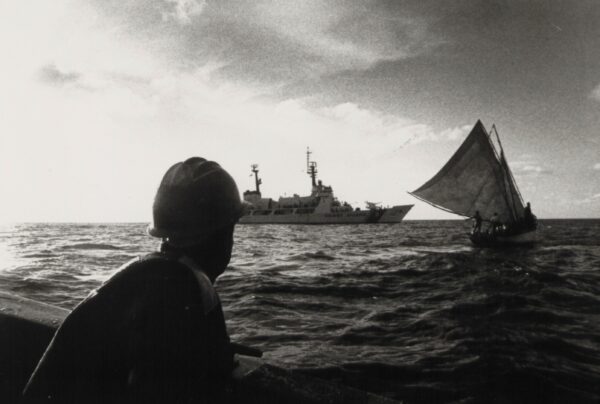
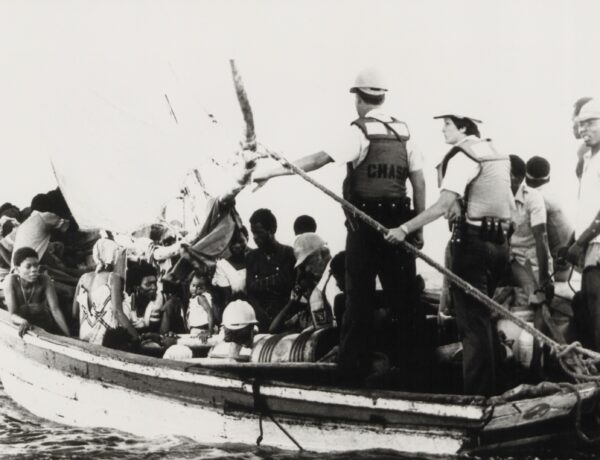
With the Exoribe’s occupants safely settled aboard, Capt. Douglas G. Currier, commanding officer of the Chase, ordered a course to Port-Au-Prince at 8.2 knots. Chase moored at the Port-au-Prince municipal pier late the next afternoon to repatriate the persons recovered from the Exoribe. Officials of the Haitian Red Cross were on hand to manage the process. Within two hours, all persons were processed, and Chase was ready to get underway to resume patrol.
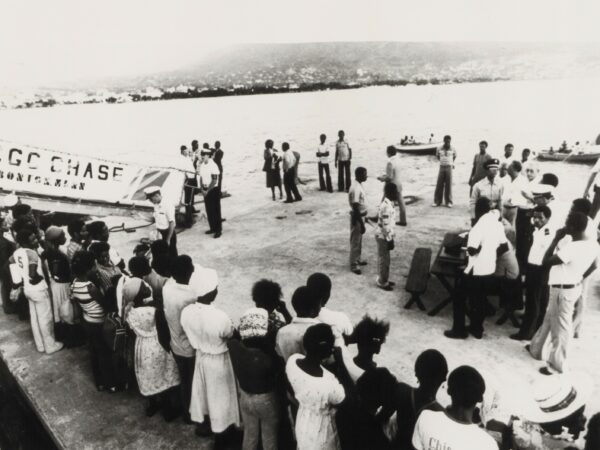
The presence of cutters in the Windward Pass and the termination of the granting of Cuban-Haitian status to new arrivals rapidly and dramatically deterred subsequent attempts by Haitian boats to reach south Florida by sea. The number of undocumented arrivals in Miami were cut in half in the same month the patrol began and reduced to only 47 in November.
| Month | 1977 | 1978 | 1979 | 1980 | 1981 |
|---|---|---|---|---|---|
| January | 0 | 12 | 8 | 577 | 769 |
| February | 0 | 20 | 12 | 308 | 262 |
| March | 0 | 35 | 38 | 1,401 | 530 |
| April | 0 | 94 | 44 | 1,174 | 475 |
| May | 96 | 178 | 75 | 1,266 | 803 |
| June | 0 | 630 | 171 | 1,456 | 1,507 |
| July | 0 | 454 | 219 | 1,731 | 1,717 |
| August | 77 | 206 | 223 | 1,874 | 978 |
| September | 45 | 454 | 185 | 2,280 | 629 |
| October | 0 | 99 | 637 | 2,280 | 306 |
| November | 52 | 17 | 330 | 1,021 | 47 |
| December | 4 | 62 | 580 | 543 | 46 |
| Totals | 274 | 1,815 | 2,522 | 15,093 | 8,069 |
A table showing the record rate of undocumented Haitians flowing to the U.S. during the year after the end of the Mariel Boatlift in September 1980. In response, President Ronald Reagan issued Executive Order 12324, which resulted in the implementation of the Haitian Migration Interdiction Operation by the Coast Guard on Oct. 10, 1981. The flow rapidly dropped after the first Haitian boat was interdicted by the Coast Guard and those aboard returned to Port Au Prince.
Immigration and Naturalization Service, INS Reporter, Summer 1982, Volume 30, No. 4, p. 6; General Accounting Office, “Detention Policies Affecting Haitian Nationals,” GAO/GDD-83-68, June 16, 1983
Over the next decade, the number of attempts by Haitian boats to risk the dangerous 600-to-700-mile journey to the U.S. would remain low, except for short term spikes spurred by U.S. policy or court decisions that appeared to ease immigration restrictions. Although originally conceived as a 90-day operation, the overwhelming success of HMIO led to its extension and later integration into the Coast Guard’s overall Alien Migrant Interdiction Operations in the early 1990s.
National Coast Guard Museum insider tip: Visitors will have the opportunity to learn more about the Coast Guard’s Migrant Interdiction Operations in the Migrant Operations Exhibit on Deck03 of the museum!
